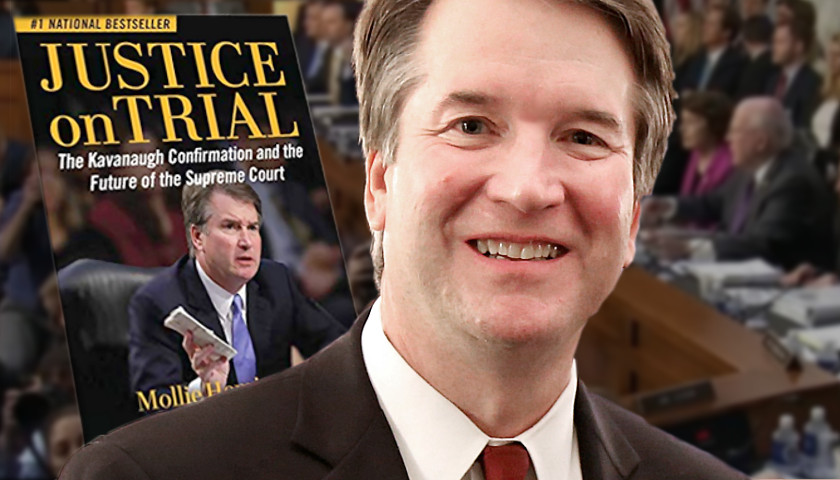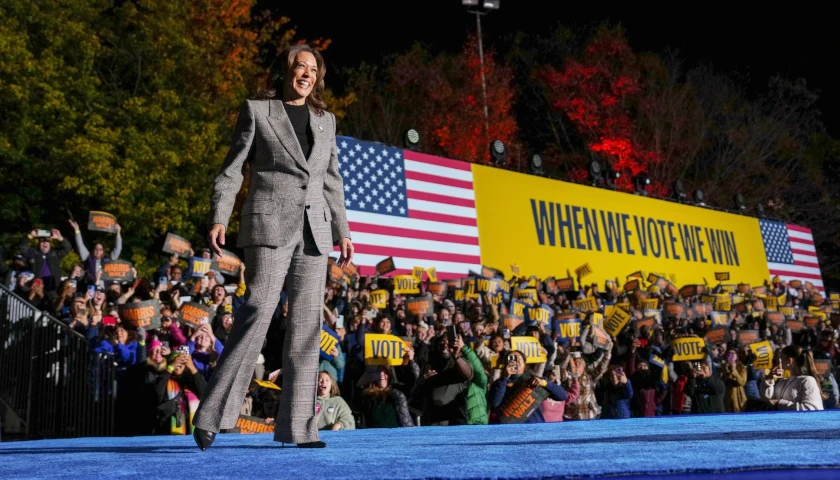by Julie Kelly
The Left’s crusade to destroy Supreme Court Justice Brett Kavanaugh isn’t over yet. Last week, House Judiciary Committee Chairman Jerrold Nadler (D-N.Y.) sent a letter to the National Archives to demand the release of any records related to Kavanaugh’s tenure in the George W. Bush White House from 2001 to 2006.
Shortly after Democrats regained control of the House of Representatives last year, Nadler was overheard talking on his cell phone to discuss how—and if—his committee should pursue impeachment against Kavanaugh.
“The worst-case scenario—or best case depending on your point of view—you prove he committed perjury, about a terrible subject and the Judicial Conference recommends you impeach him,” Nadler told to an unknown caller while traveling on the Acela train shortly after the November election.

The journalist who overheard Nadler’s conversations, Mollie Hemingway of The Federalist, has co-authored a new book about the Kavanaugh travesty that roiled the nation last fall and put the Left’s most despicable tactics on full display. In Justice on Trial, Hemingway and Carrie Severino, chief counsel and policy director of the Judicial Crisis Network, one of the many organizations that worked behind the scenes to get Kavanaugh confirmed, describe in painful detail how the attempted political assassination of Kavanaugh came together, identify the powerful architects of the hit job, and catalog the people and relationships wounded in the process.
The book is sourced from interviews with more than one hundred people, including President Trump, White House officials, senators and Kavanaugh’s associates and friends. Even though it’s only been a year since the Kavanaugh confirmation hearings and subsequent ad hoc trial featuring accuser Christine Blasey Ford, the book provides a necessary refresher in what exactly transpired and a primer to remind the Right what to expect during the 2020 election cycle, let alone another Supreme Court nomination.
A Long Summer, A Brutal Autumn
The battle to oppose Kavanaugh, as Hemingway and Severino explain, started before his name officially was announced by the White House. After an extensive vetting process in the early summer of 2018, Trump tapped Kavanaugh to be his choice to succeed retiring Justice Anthony Kennedy.
“As the announcement of Kavanaugh’s appointment was made, a large crowd gathered outside the Supreme Court in a protest organized by the Center for American Progress (CAP), funded by George Soros and founded by John Podesta, a close aide to Barack Obama and the Clintons,” the authors explain in chapter three. “As they waited to find out who it was, they chanted “Hey, hey! Ho, ho! The patriarchy has got to go!’”
Kavanaugh and his team spent the summer getting ready for what would be harsh post-Labor Day hearings before the Senate Judiciary Committee; Hemingway and Severino give an inside view about how the White House, particularly Don McGahn, Trump’s lawyer and a personal friend of the nominee, extensively prepped Kavanaugh to handle the committee’s interrogations, especially since a handful of potential Democratic presidential candidates were expected to make news with their questioning.
“In the full-blown moots . . . the team, taking on the roles of senators, peppered him with questions about his cases and hot-button issues,” the authors write in chapter four. “[Kavanaugh’s] more liberal clerks were particularly helpful in anticipating how senators from across the political spectrum—including the all-important Susan Collins [senior U.S. senator from Maine]—would view his responses. They even prepared for protestors by having younger White House staffers sit in on the moots and spontaneously erupt with rage.”
Despite some predictable and embarrassing theatrics, including Senator Cory Booker’s “I am Spartacus” preening, the Democrats didn’t land any fatal blows; the hearings ended on September 7 and Senate Judiciary Committee chairman Charles Grassley announced a vote would be scheduled for the week of September 17.
Then, as Hemingway and Severino write in chapter five, “all hell” broke loose.
Dianne Feinstein and the Christine Blasey Ford Set-Up
While Kavanaugh worked diligently to answer the committee’s astonishing 1,287 additional questions before the vote, The Intercept, an online publication funded by billionaire eBay founder and Trump foe, Pierre Omidyar, posted an article on September 12 that confirmed Senator Dianne Feinstein (D-Calif.), the committee’s ranking member, had a letter from a constituent claiming she had an “incident” with Kavanaugh in high school in the early 1980s.
 After an executive business meeting of the Judiciary committee the next day, Feinstein finally told Grassley about the letter: “Feinstein and a staff member pulled Grassley and one of his staffers into the small lavatory off the committee’s anteroom and closed the door. In that awkward setting she told him for the first time about the letter that had been in her possession since July 30. She wouldn’t show it to him.”
After an executive business meeting of the Judiciary committee the next day, Feinstein finally told Grassley about the letter: “Feinstein and a staff member pulled Grassley and one of his staffers into the small lavatory off the committee’s anteroom and closed the door. In that awkward setting she told him for the first time about the letter that had been in her possession since July 30. She wouldn’t show it to him.”
News of the unverified allegations dominated media coverage, even though no one aside from a few Democratic operatives knew the woman who had written the letter. Kavanaugh’s female friends and associates rallied to his side, co-signing a letter on his behalf and appearing on cable programs but it wouldn’t be enough to combat the tsunami of coverage about the accusations in outlets such as The New Yorker and Politico.
On Sunday, September 16, Kavanaugh would learn the name of his accuser from a Washington Postreporter: Christine Blasey Ford. And the Post reporter admitted she had been working on the story with Ford since early July.
After the call with the reporter, Kavanaugh told his wife, Ashley, the news. “The worst part of the day for Kavanaugh was calling his mother,” Hemingway and Severino write. “He knew she would be devastated. The hearings and follow-up questions had been abusive but a public accusation of sexual assault showed how much worse it could get.”
What happened next is a subject for future scrutiny. The authors mostly commend Grassley’s handling of the accusations, but he deserves more criticism for his repeated acquiescence to the Ford-fueled hysteria on the Left and NeverTrump Right—especially since Feinstein had violated committee protocol by withholding the letter and had been in touch with Ford over the summer.

Further, Ford’s original story was filled with inconsistencies and vague claims unworthy of the serious attention it received. But Grassley made every accommodation possible in spite of Kavanaugh’s request for an immediate hearing. “He knew that with each passing day the media would elaborate on their portrait of a sexual predator and activists would redouble their search for dirt.”
Which is exactly what happened. In the excruciating two weeks between the initial reports and the Capitol Hill showdown between Kavanaugh and Ford on September 27, as Grassley continued to extend the deadline for Ford to testify—the authors calculate six extensions in total—more uncorroborated and inflammatory stories about Kavanaugh’s behavior emerged.
Reporters scrubbed his high school yearbook and hounded former classmates; women flooded social media, editorial pages, and cable shows with their own irrelevant stories of past sexual abuse and assault at the hands of men who were not Brett Kavanaugh, as if their unrelated experiences might authenticate the sketchy evidence that Kavanaugh’s accusers couldn’t provide themselves. The White House and congressional Republicans seemed flat-footed and did not effectively respond, cowered by the ongoing #MeToo movement, despite having plenty of evidence that would discredit Ford. President Trump, to his credit, never seemed to waver in his support for his nominee.
Unpacking the Show Trial
Chapters eight and nine of Justice on Trial are the must-read portions of the book. They offer an infuriating and painful depiction of the grotesque “trial” that the Senate Judiciary committee conducted in front of the nation. Republicans deferred their role to an experienced sex crimes investigator, a move that was met both with praise and criticism, since the questioner only was alloted five-minute increments to ask Ford questions.
 But Kavanaugh’s emotional response to the unfounded accusations and attacks on his character, reputation, and family is powerfully recalled by Hemingway and Severino in chapter nine. I remember my own reaction as I watched the hearing in a D.C. restaurant that afternoon, with tears streaming down my face as I looked at his crushed wife seated behind him as he talked about how his young daughter prayed for Ford. I wasn’t alone. “The hearing room was filled with people crying,” they write. “Kavanaugh’s parents were there to support him and could barely maintain their composure. Watching their anguish over their only son’s ordeal was brutal for the other members of Kavanaugh’s team.”
But Kavanaugh’s emotional response to the unfounded accusations and attacks on his character, reputation, and family is powerfully recalled by Hemingway and Severino in chapter nine. I remember my own reaction as I watched the hearing in a D.C. restaurant that afternoon, with tears streaming down my face as I looked at his crushed wife seated behind him as he talked about how his young daughter prayed for Ford. I wasn’t alone. “The hearing room was filled with people crying,” they write. “Kavanaugh’s parents were there to support him and could barely maintain their composure. Watching their anguish over their only son’s ordeal was brutal for the other members of Kavanaugh’s team.”
After the draining spectacle, some of the accusations against Kavanaugh fell apart as concerns over his “temperament” became the new narrative. Grassley scheduled a vote on September 28, but there was more behind-the-scenes drama as Hemingway and Severino describe the way senators tried to lobby retiring Senator Jeff Flake (R-Ariz.):
In the epic, hours-long fight outside the meeting room, fistfights nearly broke out. One senator told another that he wanted to wring his neck. A staffer who was bringing lunch to her hungry boss found herself in the middle of the scrum, with Ted Cruz inadvertently standing on her foot and Sheldon Whitehouse spraying her with saliva as he debated a colleague. Veteran staffers had never seen anything so chaotic in the Senate.
Finally, on October 6, 2018, Brett Kavanaugh was confirmed as an associate justice for the Supreme Court. The authors devote an entire chapter to Susan Collins, the Maine Republican who bravely stared down her most savage political opponents to offer the pivotal vote that ensured Kavanaugh’s spot on the nation’s highest court.
But the fallout continued. Professional reputations, including Kavanaugh’s, were irreparably damaged. Relationships were strained or ended. “Women who attested to Kavanaugh’s character in high school lost friends. Many had to drop off of social media during the confirmation process. All lost a degree of privacy and peace when their names were made public.” No matter what Kavanaugh, now 54, accomplishes on the court, his confirmation will be part of his legacy.
And now, despite the wreckage left behind from the Democrats’ rampage against Kavanaugh, they appear poised to do more damage. As Senator Lindsay Graham (R-S.C.) raged to his Democratic colleagues at the conclusion of the Kavanaugh-Ford trial, “Boy, you all want power. God, I hope you never get it.” On the House side at least, the Democrats do have power for at least the next 16 months—and they plan to use it as much as they can against Brett Kavanaugh.
– – –
Julie Kelly is a political commentator and senior contributor to American Greatness. Her past work can be found at The Federalist and National Review.





